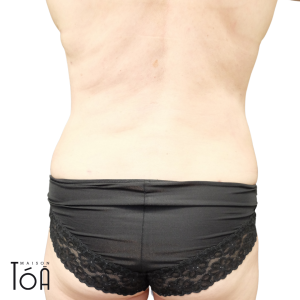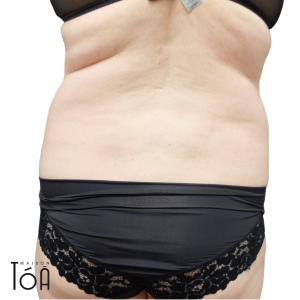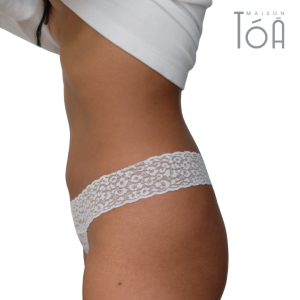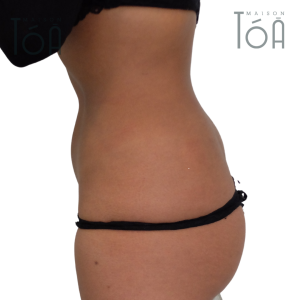Liposuction
Not all areas of the body can be reduced by discipline, sport and a healthy diet. Many fat deposits have accumulated over the years in certain areas of the body and are resistant to various diets. In cosmetic surgery, liposuction is probably one of the most popular treatments. It allows us to reshape the figure by withdrawing the deep fat deposits. Maison Tóā offers you a great expertise in this field of cosmetic surgery!




How is a Liposuction conducted ?
Liposuction is a cosmetic surgery procedure used to sculpt certain parts of the body. The word liposuction literally means to suck out (suction) the fat (lipo). 1 liter of fat weighs barely 500 grams. It is therefore not a method to lose weight easily, but a solution to correct the silhouette. The treatment is particularly effective for individuals with a firm skin, a balanced diet and a certain amount of sports activity, but who are unable to get rid of certain particularly resistant fatty masses. The areas usually concerned are the chin, arms, abdomen, flanks, hips, thighs, knees, and calves.
Liposuction is the most commonly performed cosmetic surgery procedure in the world. Non-invasive alternatives (ultrasound, cryolipolysis or other non-invasive methods) do not provide results as spectacular as this procedure, which often allows, in addition to completely reshaping the figure, to lose several centimeters of waist or thigh.
The fat that is sucked out is permanently removed from the treated area. It is only in case of weight gain that the remaining fat cells can fill up with fat again. This is why it is important to maintain a stable weight after liposuction and to maintain a healthy lifestyle. During the first consultation, it is necessary to make an assessment of the elasticity of your skin, which varies according to your age and the areas of your body, to check your medical history, but also to verify that liposuction is the most suitable treatment. In the case of significant skin excess, a dermolipectomy (thigh lift, arm lift or abdominoplasty) will be more appropriate. A preoperative assessment and photographic evaluation will be performed.
When will the results be visible?
The results are not immediately visible. Indeed, we infiltrate as much water as we remove fat during the surgery. You will initially be even more swollen than normal (this is why you must absolutely put on a support girdle). The excess water will gradually be eliminated by your body in the 15 days following the surgery. You will see the first results at that time. And for a definitive result, it will be observed after 3 months, once the edemas and hematomas have been completely reabsorbed and the skin retracted. To help reduce postoperative edema more quickly, a few sessions of lymphatic drainage may be useful.
How does the session take place?
First of all, an initial consultation with your surgeon allows you to determine the areas to be treated.
Liposuction of a single area can be performed under pure local anesthesia. But in most cases, it is an operation that is performed under local anesthesia with sedation or under general anesthesia. The procedure lasts between 2-3 hours.
By means of multiple small incisions of 3 to 4 mm, placed in inconspicuous areas, we proceed to an infiltration of a physiological water solution containing adrenaline and local anesthesia. This will put tension on the area to be treated and the adrenaline will reduce bleeding. With the help of cannulas of different diameters, the fat will be sucked out as smoothly as possible. The incisions are then closed with a stitch of non-absorbable thread that will be removed after 1 week. This procedure is most often performed on an outpatient basis, only in the case of extensive liposuction (more than 4 liters of fat), 1 night of hospitalization is recommended.
What are the postoperative procedures?
First of all, an initial consultation with the team at Maison Tóā allows us to determine the areas to be treated. At this time, the practitioner checks the patient’s weight, percentage of body fat and thickness of subcutaneous fat. He marks all the areas on which he will intervene and makes sure to respect the harmony of the silhouette. In order for liposuction to produce successful and natural results, it is essential to respect the specificities of the different areas treated.
Liposuction or liposuction allows for the reduction of excess fat in the abdominal area, love handles, saddlebags, inner thighs and any other area of predilection of fat cells. This widely used aesthetic procedure is highly effective in eliminating excess fat and fat cells permanently.
Liposuction of a single area can be performed under pure local anesthesia. But in most cases it is an operation that is performed under local anesthesia with sedation or under general anesthesia. The duration of the surgery is between 2 and 3 hours. It is performed in our cosmetic surgery clinic based in Lausanne, in the canton of Vaud.
The procedure for liposuction is as follows. Through multiple small incisions of 3 to 4 mm, placed in inconspicuous areas, we proceed with an infiltration of a physiological water solution containing adrenaline and local anesthesia. This will put tension on the area to be treated and the adrenaline will reduce bleeding. With the help of cannulas of different diameters, the fat will be sucked out as smoothly as possible to ensure a natural result.
The incisions are then closed with a stitch of non-absorbable thread that will be removed after 1 week. This procedure is most often performed as an outpatient procedure, only in the case of extensive liposuction (more than 4 liters of fat), 1 night of hospitalization is desirable.
Liposuction can be combined with other surgical procedures (abdominoplasty, cruroplasty, brachioplasty, facelift). The removed fat can also be recovered in order to reinject it into other areas of the body, such as the breasts (under certain conditions) as part of a mammoplasty and in the buttocks, we speak of liposculpture by lipofilling.
Do not hesitate to discuss your aesthetic goals with your plastic surgeon who will be able to advise you on the most appropriate procedures to combine with liposuction.
The after-effects of a liposuction procedure are longer than for a treatment that does not require surgery. However, the postoperative period is not too long and the final result tends to make you forget the postoperative period. The amount of fat removed also has an influence on the duration of the post-operative period. The day after the operation, the patient can shower. A compression girdle (lipopanty) is put in place at the end of the operation and must be kept on permanently for 1 month, day and night, except when showering. This girdle allows the skin to regain its elasticity and above all to adapt to the new contours of the figure.
A return to office activities is quick, as early as the 3rd postoperative day. After 1 week for more sustained activities. Resumption of sports is recommended after 1 month, although light activity such as walking can be done.
In order for the effects of liposuction to be successful over the long term, it is strongly advised by Maison Tóā to avoid rapid and excessive weight gain.
What are the possible complications?
As with any surgical procedure, liposuction can lead to post-operative complications, which fortunately remain rare through a medical check-up performed by your team at Maison Tóā prior to the procedure. Complications may include the following:
- hematomas (lasting from 1 to 2 weeks)
- edema (edema will persist for about three months)
- temporary loss of sensitivity of the treated area (which can last up to several months)
- thrombosis, phlebitis and pulmonary embolism. These risks are increased in case of overweight, notion of venous insufficiency (and taking the pill in some cases) and too much fat removal (postoperative anemia increases the risk of phlebitis). Rapid post-operative mobilization, support stockings in certain cases and prevention by anticoagulant reduce this risk.
- Infections: they are rare given the small incisions
- Irregularity and asymmetry of the aspirated areas
Q&A
Liposuction can be combined with other surgical procedures (abdominoplasty, cruroplasty, brachioplasty, facelift). The removed fat can also be recovered in order to reinject it into other areas of the body, such as the breasts (under certain conditions) as part of a mammoplasty and in the buttocks, we speak of liposculpture by lipofilling.
Do not hesitate to discuss your aesthetic goals with your plastic surgeon who will be able to advise you on the most appropriate procedures to combine with liposuction.
The after-effects of a liposuction procedure are longer than for a treatment that does not require surgery. However, the postoperative period is not too long and the final result tends to make you forget the postoperative period. The amount of fat removed also has an influence on the duration of the post-operative period. The day after the operation, the patient can shower. A compression girdle (lipopanty) is put in place at the end of the operation and must be kept on permanently for 1 month, day and night, except when showering. This girdle allows the skin to regain its elasticity and above all to adapt to the new contours of the figure.
A return to office activities can take place quickly, as early as the 3rd postoperative day. After 1 week for more sustained activities. Resumption of sports is recommended after 1 month, although light activity such as walking can be practiced.
In order for the effects of liposuction to be successful over the long term, it is strongly advised by Tóā House to avoid rapid and excessive weight gain.
Not always… cellulite can either come from a certain amount of skin laxity, or from fibrous septa that cause skin retraction. Often both causes are possible. Liposuction can sometimes be used to cut these fibrous septa with the help of cannulas, but this is not always possible. And in case of skin laxity, lipofilling can be used to treat certain areas.
After examining the fatty deposits, your plastic surgeon may advise you to undergo additional treatment to eliminate cellulite and the orange peel appearance.
Not really. Liposuction is a procedure that targets problem areas with a high concentration of fat. During the procedure, you don’t just “drain” fat evenly from all parts of the body, you target a specific area (belly, thigh, chest, etc.) and remove the fat from that area. For example, if you have particularly wide hips and a narrow waist, liposuction of the hips could yield significant results and you could probably wear smaller clothing sizes. If the fat is evenly distributed throughout your body, liposuction may not change your size.
Safety: Liposuction does not pose a risk to your pregnancy. Practicality: The value of surgery before pregnancy depends more on whether liposuction is right for you. If you have concentrated clusters of fat that could be effectively targeted by liposuction, it is in your best interest to have the surgery done, either before or after pregnancy. After surgery, these fat cells disappear for good, so there is no need to worry about them coming back after pregnancy. What can happen is that new fatty deposits form after your pregnancy. But that would require another operation and another decision.
The answer is simple: no. First of all, liposuction is a surgical procedure. Other methods to reduce fat such as external ultrasound or cryolipolysis or endermology are not the same as liposuction. But what matters to you is the result, and the result usually differs dramatically between non-surgical and surgical approaches. Cryolipolysis, which destroys fat by cold, also allows for permanent fat removal, but in a less radical way and requiring several treatments to hope for a result close to surgery. The only real way to get rid of fat is to remove it surgically. But this brings us to another problem: the purpose of liposuction is to remove fat from a problem area in a very targeted way. Again, liposuction is not just about removing fat, but also about “sculpting” your body to achieve the desired appearance.

Ready for liposuction? Before jumping in, you need to book a consultation with me so that I can understand your story and your needs. Once we have established trust, we can move forward and plan a new silhouette for your body…
Intervention
-
Duration
1 – 4 hours
-
Hospitalization
Ambulatory or 1 night
-
Recovery
Work: 2 weeks
Sport: 2 weeks -
Price
From 4’500.-
